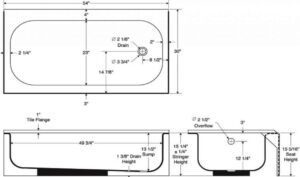A bathtub is a place of solitude where you can take some time to yourself. It’s a space for peace and relaxation, and it should be just the right size for your bathroom. But how do you know what size bathtub is right for your bathroom?
There are a few factors to consider when choosing a bathtub, such as the size of your bathroom, the number of people who will be using the tub, and your personal preferences. To help you choose the perfect bathtub size for your home, here is a guide on how to pick the right one.
What Is the Standard Bathtub Size?
The standard size for a bathtub is 60 inches long by 30 inches wide. This size tub can comfortably fit one or two people and is the most popular size among homeowners.
If you have a small bathroom, you may not have enough space for a standard-sized bathtub. In this case, you can opt for a smaller tub that a minimum size of 48 inches long and 28 inches wide.
Large tubs that are up to 72 inches long and 42 inches wide are also available for those who have extra space in their bathroom. These tubs can good choice for those who enjoy soaking in a tub or want more room to move around.
What Is the Standard Water Depth for Bathtubs?
The standard water depth for a bathtub is 14 inches. This depth allows you to fully immerse yourself in the tub without worrying about the water spilling over the edge.
The average bathtub can hold around 40-60 gallons of water, which is enough to fill the tub up to the standard 14-inch depth. This is enough to comfortably submerge an adult, while still leaving room for some movement.
| Type | Lenght | Width | Height |
| Alcove Bathtub | 60 inches | 32 inches | 16 inches |
| Drop-in Bathtub | 60 inches | 42 inches | 18 inches |
| Oval Bathtub | 60 inches | 42 inches | 24 inches |
| Whirpool Bathtub | 60 inches | 32 inches to 36 inches | 18 inches to 20 inches |
| Corner Bathtub | 60 inches | 32 inches to 60 inches | 18 inches to 22 inches |
| Freestanding Bathtub | 60 inches | 30 inches | 18 inches |
| Round Bathtub | 60 inches | 32 inches | 16 inches |
| Small Bathtub | 48 inches | 30 inches | 14 inches |
Type of Bathtubs
Alcove bathtub
An alcove bathtub is the most common type of tub. It is a type of tub that fits into an alcove, or recessed area, in your bathroom. Alcove tubs are usually rectangular or oval in shape and can be installed with a shower head above the tub or on the wall.
Alcove bathtubs are best suited for bathrooms that are at least 5 feet wide. If you have a smaller bathroom, you may be able to install an alcove tub by taking out a portion of the wall or using a shower curtain.
Drop-in bathtub
A drop-in bathtub is designed to sit on top of a raised platform or pedestal in your bathroom. These tubs are usually placed in the middle of the room, making them a focal point in the bathroom. They can be used in both contemporary and traditional bathrooms.
If you have a large bathroom and want to make a statement, a drop-in bathtub is a good option. These tubs are also a good choice if you have young children, as they can be easily accessible from all sides.
Oval bathtub
Oval bathtubs are a more modern take on the traditional rectangular tub. They are elongated and have rounded corners, making them provide a more spacious feel. These tubs can also be a good choice if you have limited space in your bathroom.
Most oval tubs are freestanding, meaning they are not attached to the wall. This can make them easier to install, but it also means they may require more support.
Whirlpool bathtub
A whirlpool bathtub is a type of tub that has jets that create a circulating water system. These tubs are designed for relaxation and can be used to massage sore muscles. Whirlpool tubs can be either freestanding or drop-in.
If you’re looking for a luxurious and relaxing experience, a whirlpool bathtub is a good choice. However, these tubs can be more expensive and require more maintenance than other types of tubs.
Corner bathtub
A corner bathtub is a type of tub that is designed to fit into a corner of your bathroom. These tubs are usually rectangular or triangular in shape and can be either freestanding or drop-in.
Corner bathtubs are a good choice if you have a small bathroom and want to make the most of your space. These tubs can be less expensive than other types of tubs and are often easier to clean.
Freestanding bathtub
A freestanding bathtub is a type of tub that is not attached to the wall or any other surface. These tubs are usually oval or round in shape.
Freestanding tubs are a good choice if you want to add a touch of luxury to your bathroom. They are also a great choice if you have a small bathroom, as they don’t require any extra space around them for installation.
Round bathtub
A round bathtub is a type of tub that is circular in shape. These tubs are usually small and can be either freestanding or drop-in.
Round bathtubs are a great option for bathrooms of all sizes. They offer a clean, simple look that can complement any décor. Plus, they’re easy to keep clean since there are no tight corners for dirt and grime to accumulate.
Small bathtub
Small bathtubs are a good choice for people who have limited space in their bathrooms. They offer all the benefits of a standard-sized tub but take up less space.
Plus, they’re often more affordable than other types of tubs.
However, small bathtubs may not be as comfortable as larger tubs and may not have all the features that you want.
How to Measure Your Space for a Bathtub?
Once you’ve decided on the type of bathtub you want, you’ll need to measure your bathroom to make sure it will fit. Here’s how to do it:
1. Measure the length and width
Use a tape measure to determine the length and width of your bathroom. Then, take into account the amount of space you have around your toilet, sink, and other fixtures. Make sure to leave enough space. You’ll need about 18 inches of clearance on each side of the tub for comfortable use.
2. Measure the height
Next, you’ll need to measure the height of your bathroom. This is important if you’re planning on installing a drop-in tub. You’ll need at least 5 feet of clearance from the top of the tub to the ceiling.
3. Measure the doorways
This will give you an idea of the largest tub that you can realistically fit through your doorways. You’ll need to account for the tub, any hardware, and the space around it.
4. Draw a floor plan
Once you’ve measured your bathroom, it’s a good idea to draw a floor plan. This will help you visualize the space and figure out the best way to arrange your fixtures.
5. Determine the best location for your tub
After you’ve measured your space and drawn a floor plan, you can start to decide on the best location for your tub. Keep in mind the layout of your bathroom and where the plumbing is located. You’ll also want to consider how much privacy you want and whether you want your tub to be the focal point of the room.
6. Determine the type of installation
You’ll also need to decide what type of installation you want. Freestanding tubs can be installed on any level surface, including concrete, tile, and wood. Drop-in tubs need to be installed in an alcove or against a flat wall. Corner tubs need to be installed in a corner.
7. Choose the right tub size
Now that you know the type of tub you want and where you want to install it, you can start to narrow down your choices. Pay close attention to the dimensions of each tub to make sure it will fit in your space.
You’ll also need to consider how many people will be using it. A standard 60-inch tub can comfortably seat two people. But, if you have a large family or entertain often, you may want to choose a larger tub.
Conclusion
When deciding on the right bathtub size for your bathroom, it is important to keep in mind the available space, the number of people who will be using the tub, and your personal preferences.
Ultimately, the goal is to choose a size that will be comfortable and practical for your needs. If you have any questions or concerns, be sure to consult with a professional before making your final decision.











